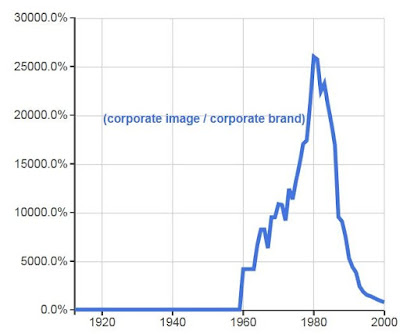One word in the headlines last week seemed like a throwback to an earlier era:
As Trump moves to soften his image, Democrats seek to harden it
— The Washington Post
Donald Trump to reshape image, new campaign chief tells G.O.P.
—The New York Times
Trump surrogates say GOP front-runner “projecting an image” during primaries
— Fox News
It was in the 1960s that politicians, their handlers, and the people who write about them discovered image. The word carries the cynical implication that voters, like shoppers, respond to the surface image rather than the substance – the picture on the box rather than what’s inside. A presidential campaign was based on the same thing as an advertising campaign – image. You sold a candidate the same way you sold cigarettes, at least according to the title and book jacket of Joe McGinnis’s book.

Then, sometime around 1980, image began to fade. In its place we now have brand. I went to Google N-grams and looked at the ratio of image to brand in both the corporate and the political realm. The pattern is nearly identical.


The ratio rises steeply from 1960 to 1980 – lots more talk about image, no increase in brand. Then the trend reverses. Sightings of image were still rising, but nowhere nearly as rapidly as brand, which doubled from 1980 to 2000 in politics and quadrupled in the corporate world.
Image sounds too deceptive and manipulative; you can change it quickly according to the needs of the moment. Brand implies permanence and substance (not to mention Marlboro-man-like rugged independence and integrity.) No wonder people in the biz prefer brand.
Decades ago, when my son was in grade school, I met another parent who worked in the general area of public relations. On seeing him at the next school function a few weeks later, I said, “Oh right, you work in corporate image-mongering.” I thought I said it jokingly, but he seemed offended. He was, I quickly learned, a brand consultant. Image bad; brand good.
In later communications, he also said that a company’s attempt to brand itself as something it’s not will inevitably fail. The same thing supposedly goes for politics:
“One thing you learn very quickly in political consulting is the fruitlessness of trying to get a candidate to change who he or she fundamentally is at their core,” said Republican strategist Whit Ayres, who did polling for Rubio’s presidential campaign before he dropped out of the race. “So, is the snide, insulting, misogynistic guy we’ve seen really who Donald Trump is? Or is it the disciplined, respectful, unifying Trump we saw for seven minutes after the New York primary?
These consultants are saying what another Republican said a century and a half ago: “You can fool all the people some of the time, and some of the people all the time, but you cannot fool all the people all the time.”
This seems to argue that political image-mongers have to be honest about who their candidate really is. But there’s another way of reading Lincoln’s famous line: You only need to fool half the people every four years.
Originally posted at Montclair SocioBlog.
———————
Jay Livingston is the chair of the Sociology Department at Montclair State University. You can follow him at Montclair SocioBlog or on Twitter.
Comments 2
AG — April 25, 2016
Perhaps I am being too generous, but I think the same politician/media consumer dynamic can be viewed in a different -more forgiving- light.
Politicians are also humans who posses both good and bad traits. Sometimes there is disagreement if a politician is using a good trait towards a bad end (work ethic applied towards a goal with which I disagree). Sometimes we tend to prescribe the acts of a person in one incident as representative of what actions they would take in different circumstances - and we're wrong. And sometimes we tend to prescribe internal failures of a person for their actions. We may forget to consider the circumstances that led to particular decisions (see: problems with incarceration, people that vote for Trump who in different circumstances have voted for the other populist).
So, you hire someone to make sure your good traits are no overshadowed by your bad traits. If someone disagrees with your client, they can quickly dismiss your "image mongering" and that's fine b/c the thick-headed don't listen anyways, the goal is to present your best traits to those who are willing to listen. ... tangent: maybe these consultants could start a side gig in grooming clients who lack empathy for the dating world.
Of course, what you don't do under any circumstances is try to present both sides of the issue and engage the passive media consumer who would rather: listen to someone state things they already agree with; be spoon fed what to believe. If you want more constituents on your side, the easier play is to downplay your weaknesses and play up your strengths as well as find a way to fit what you want to say within a channel in their mind instead of changing the formatting of their mind. Positionally brand yourself so you can sell hope/fear and change that conforms within the ideals of those you want supporting you.
Or, be a stick in the mud, and see how many votes you get that way.
LM — April 28, 2016
"Decades ago, when my son was in grade school, I met another parent who
worked in the general area of public relations. On seeing him at the
next school function a few weeks later, I said, “Oh right, you work in
corporate image-mongering.” I thought I said it jokingly, but he seemed
offended. He was, I quickly learned, a brand consultant. Image bad;
brand good."
Or maybe he was offended by your condescending use of the word "mongering," which has zero positive associations. I certainly would have been.